The Hidden Galaxy is an intermediate spiral galaxy located approximately 10.7 million light-years away in the northern constellation Camelopardalis (the Giraffe). It is catalogued as IC 342 in the Index Catalogue and Caldwell 5 in the Caldwell catalogue.
IC 342 lies relatively close to our own galaxy, the Milky Way. It has a diameter of 75,000 light-years and is home to around 100 billion stars. With an apparent magnitude of 9.1 and an apparent size of 21.4 by 20.9 arcminutes, it can be observed in amateur telescopes.
IC 342 was nicknamed the Hidden Galaxy because it lies behind the dusty region near the galactic equator. This makes it a challenging target to observe and image. Even though it is relatively bright, the Hidden Galaxy is obscured by thick cosmic gas and dark dust. Astronomers estimate an extinction of around 2.4 magnitudes. Without the intervening dust, IC 342 would be one of the brightest galaxies in the sky.
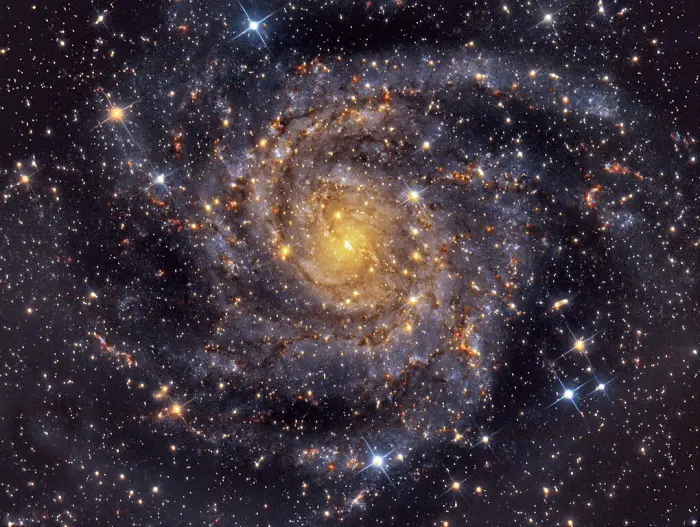
The Hidden Galaxy (IC 342), image credit: Wikimedia Commons/W4sm astro (CC BY-SA 4.0)
The Hidden Galaxy contains an H II nucleus, a central region of ionized hydrogen where many new stars are forming. Such energetic star forming regions can give birth to thousands of new stars within a couple of million years. The ultraviolet light of the young, exceptionally hot stars further ionizes the hydrogen in the region.
In 2020, an international team of astronomers confirmed that the dwarf spheroidal galaxy KKH 22 (LEDA 2807114) was the first known satellite of IC 342. Unlike spiral galaxies with developed bulges (e. g. the Andromeda Galaxy, Bode’s Galaxy, Messier 106), IC 342 and other spirals without apparent bulges do not have many satellite galaxies.
KKH 22 was discovered by a team led by Karachentsev in 2001, but it was not confirmed as a satellite until it was observed with the Advanced Camera for Surveys (ACS) aboard the Hubble Space Telescope (HST) in 2019. The dwarf galaxy spans 4,300 light-years across and lies 10.2 million light-years away.
IC 342 is one of the brightest members of the IC 342 Group, one of the nearest groups of galaxies to the Local Group in the Virgo Supercluster. The group is also known as the IC 342/Maffei Group, but recent observations have shown that the two groups of galaxies concentrated around IC 342 and Maffei 1, a massive elliptical galaxy in Cassiopeia, were not gravitationally bound.
The IC 342 Group includes KKH 22, the dwarf irregular galaxy NGC 1569, the spiral galaxy NGC 1560, the Magellanic spiral galaxy UGCA 86, and the dwarf irregular galaxies UGCA 92, Camelopardalis A, and Camelopardalis B.
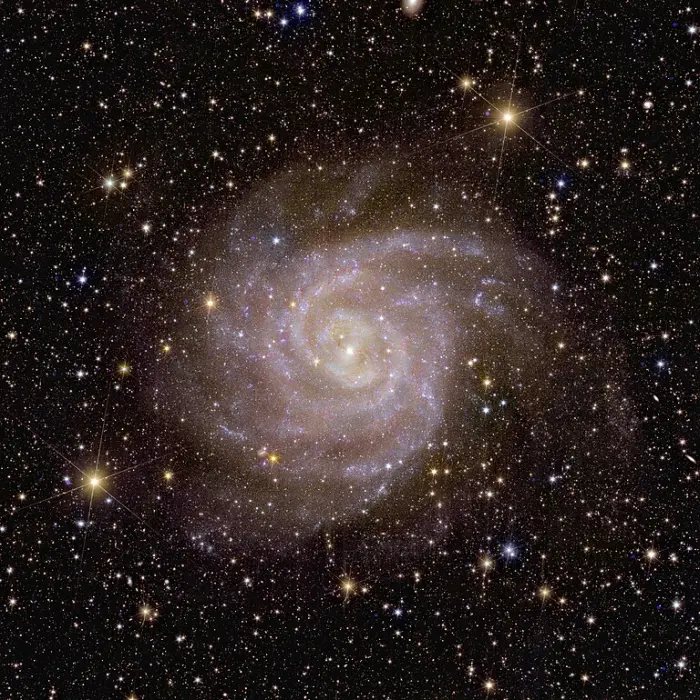
One of the first galaxies that Euclid observed is nicknamed the ‘Hidden Galaxy’. This galaxy, also known as IC 342 or Caldwell 5, is difficult to observe because it lies behind the busy disc of our Milky Way, and so dust, gas and stars obscure our view. Euclid could take this beautiful and sharp image thanks to its incredible sensitivity and superb optics. Most important here is that Euclid used its near-infrared instrument to peer through the dust and measure the light from the many cool and low-mass stars that dominate the galaxy’s mass. Image credit: ESA/Euclid/Euclid Consortium/NASA image processing by J.-C. Cuillandre (CEA Paris-Saclay) G. Anselmi (CC BY-SA 3.0 IGO)
Facts
IC 342 was discovered by the British amateur astronomer William Frederick Denning in 1892.
American astronomer Edwin Hubble initially suspected that the galaxy was a member of the Local Group. However, later observations placed the galaxy at a distance of at least 6 million light years away, well outside the Local Group.
In 1935, American astronomer Harlow Shapley found IC 342 to be the third largest galaxy in the sky by angular size, after the Andromeda Galaxy and the Triangulum Galaxy. Modern measurements give the galaxy a smaller apparent size, equivalent to one-half to two-thirds of the full Moon.
The Hidden Galaxy looks very similar to the Fireworks Galaxy (NGC 6946), another face-on intermediate spiral galaxy that is heavily obscured by dust. The Fireworks Galaxy lies 25.2 million light-years away on the border between the constellations Cepheus and Cygnus. It is known for its many supernovae.
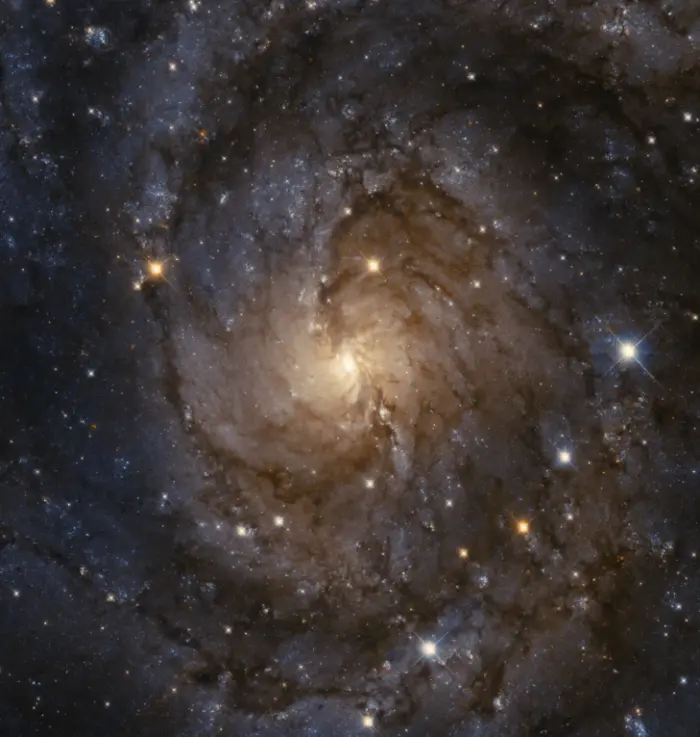
Famously overlooked grand design spiral galaxy IC 342 as seen in October 2019 by Hubble. It is situated rather close to the plane of our own galaxy, making it difficult to discern through all the dust and stars between us and it. It’s similar in size to the Triangulum Galaxy, but dimmed so much by dust that it wasn’t discovered until a couple hundred years later. Image credit: NASA, ESA, Judy Schmidt (CC BY 2.0)
Location
IC 342 is located in Camelopardalis, near the border with Cassiopeia. The celestial Giraffe is one of the faintest and northernmost constellations in the sky. It lies in the region between the brighter Ursa Minor (the Smaller Bear), Cassiopeia, Perseus, and Auriga (the Charioteer).
The Hidden Galaxy appears in the same area of the sky as the Heart and Soul nebulae in Cassiopeia. It can be found roughly halfway between Polaris in Ursa Minor and Mirfak in Perseus, close to the imaginary line extended from the bright Capella in Auriga in the direction of Errai in Cepheus. The galaxy appears near the mag. 4.39 variable star BE Camelopardalis.
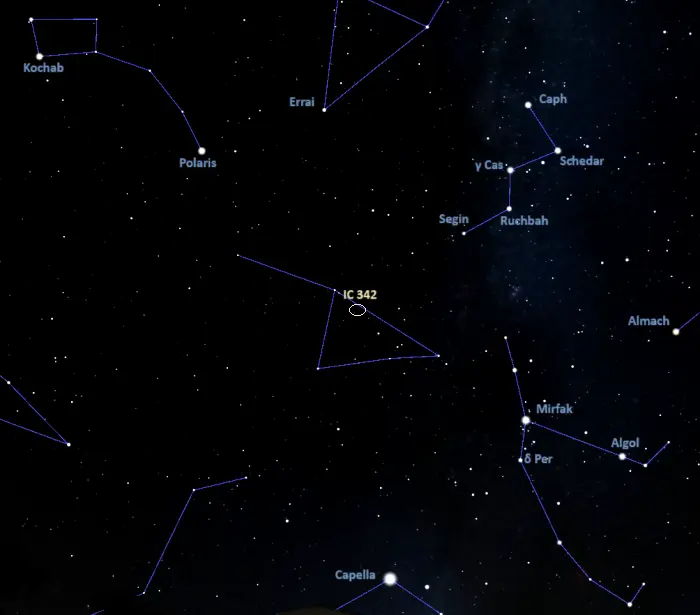
The location of IC 342 (the Hidden Galaxy), image: Stellarium
At declination +68°, IC 342 never rises for observers south of the latitude 22° S. From most of the northern hemisphere, the galaxy is visible throughout the year.
The best time to observe IC 342 and other deep sky objects in Camelopardalis is during the month of February, when the constellation appears higher above the horizon in the early evening.
Hidden Galaxy – IC 342
| Constellation | Camelopardalis |
| Object type | Spiral galaxy |
| Morphological type | SAB(rs)cd |
| Right ascension | 03h 46m 48.514s |
| Declination | +68° 05′ 46″ |
| Apparent magnitude | 9.1 |
| Apparent size | 21.4’ x 20.9’ |
| Distance | 10.7 ± 0.9 million light-years (3.3 ± 0.3 megaparsecs) |
| Redshift | 31 ± 3 km/s |
| Number of stars | 100 billion |
| Diameter | 75,000 light-years |
| Names and designations | Hidden Galaxy, IC 342, Caldwell 5, PGC 13826, LEDA 13826, UGC 2847, DW 0341+67, 2E 848, 2E 0342.0+6756, MCG+11-05-003, IRAS F03419+6756, IRAS 03419+6756, 2MASX J03464851+6805459, PSCz Q03419+6756, TC 668, UZC J034648.9+680546, Z 305-2, ZOAG G138.17+10.58, Z 0342.0+6757 |
Images
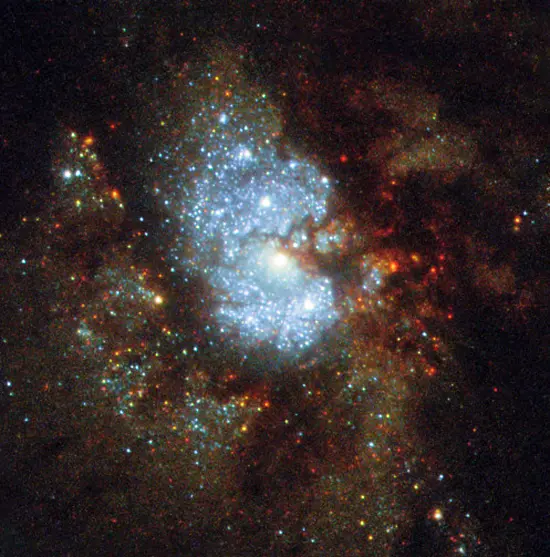
Caldwell 5, also known as IC 342, is a spiral galaxy located approximately 11 million light-years from Earth. This sparkling, face-on view of the center of the galaxy displays intertwined tendrils of glowing, rosy dust in spectacular arms that wrap around a brilliant blue core of hot gas and stars. This core is a specific type of region called an H II nucleus — an area of atomic hydrogen that has become ionized. Such regions are energetic birthplaces of stars where thousands of stars can form over a couple million years. Image credit: ESA/Hubble & NASA (CC BY 4.0)
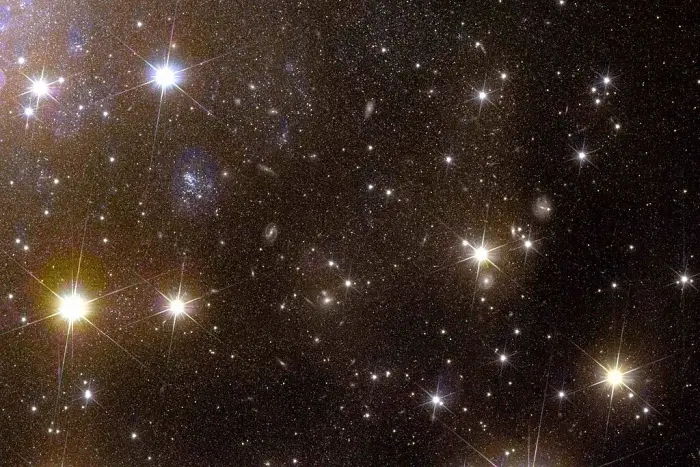
IC 342 captured by the European Space Agency’s Euclid space telescope, credit: ESA/Euclid/Euclid Consortium/NASA image processing by J.-C. Cuillandre (CEA Paris-Saclay) G. Anselmi (CC BY-SA 3.0 IGO)
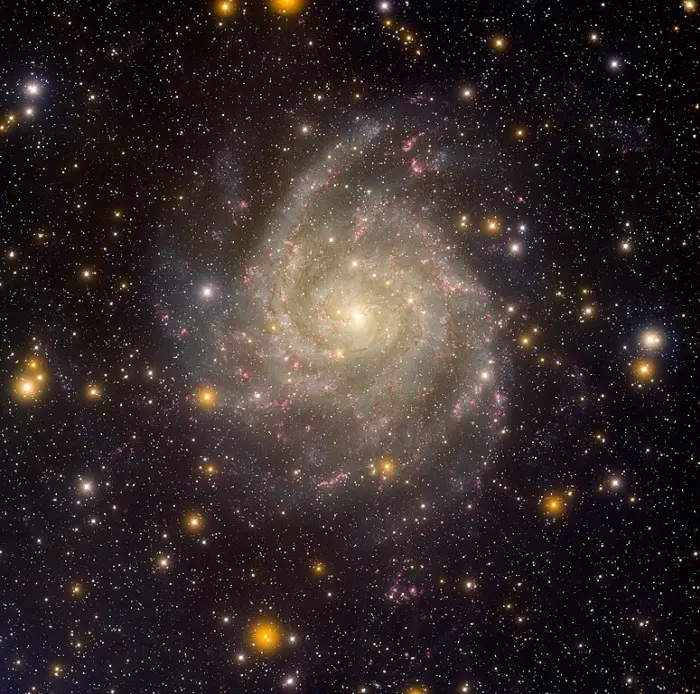
Spiral Galaxy IC 342 is located roughly 11 million light-years from Earth in the constellation Camelopardalis, “the giraffe.” Its face-on appearance in the sky — as opposed to our tilted and edge-on views of many other nearby galaxies, such as the large spiral galaxy Andromeda (M31) — makes IC 342 a prime target for studies of star formation and astrochemistry. The image, obtained in late 2006, was taken using the 64-megapixel Mosaic-1 digital imager on the Mayall 4-meter telescope. Credit: NOIRLab/NSF/AURA/T.A. Rector (NSF’s NOIRLab/University of Alaska Anchorage) & H. Schweiker (WIYN/NSF’s NOIRLab) (CC BY 4.0)
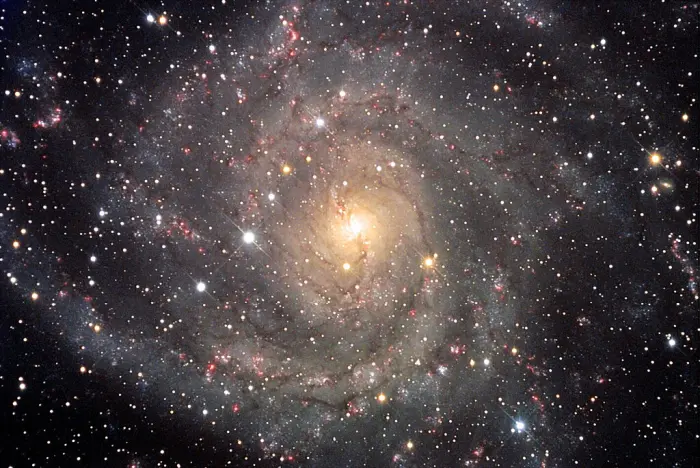
IC 342 is a nearby (14 million light years) spiral galaxy whose light is attenuated by the intervening gas and dust of our own Milky Way. It is for this reason that the galaxy is not as well known as others in the Messier catalogue. A deep exposure of this galaxy reveals it has graceful spiral arms with a myriad of star clusters and nebulae. It is often suggested that this galaxy is one of the best examples of a nearby spiral galaxy that closely resembles our own galactic home. The galaxy extends well beyond this field of view. Image credit: KPNO/NOIRLab/NSF/AURA/Ken and Emilie Siarkiewicz/Adam Block (CC BY 4.0)
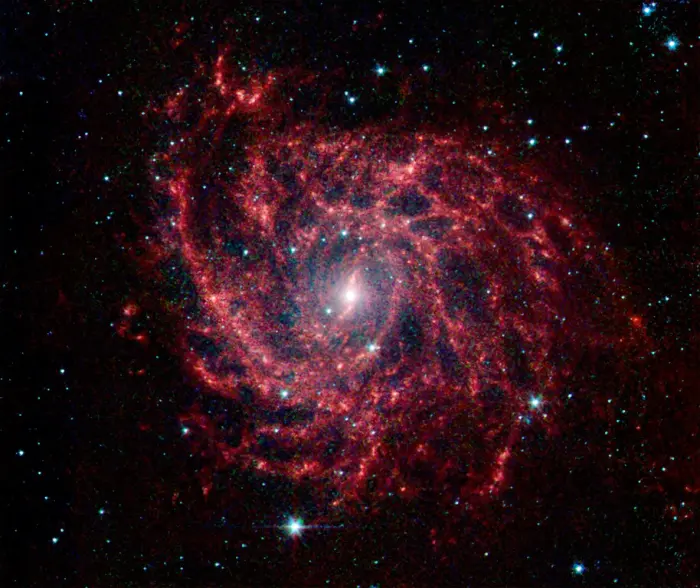
Looking like a spiders web swirled into a spiral, the galaxy IC 342 presents its delicate pattern of dust in this image from NASAs Spitzer Space Telescope. Seen in infrared light, the faint starlight gives way to the glowing bright patterns of dust found throughout the galaxy’s disk. New stars are forming in the disk at a healthy clip. Glowing like gems trapped in the web, regions of heavy star formation appear as yellow-red dots due to the glow of warm dust. The very center glows especially brightly in the infrared, highlighting an enormous burst of star formation occurring in this tiny region. To either side of the center, a small bar of dust and gas is helping to fuel this central star formation. Data from Spitzer’s infrared array camera (IRAC) are shown in blue (3.6 microns), green (4.5 microns) and red (5.8 and 8.0 microns). Credit: NASA/JPL-Caltech/J. Turner (UCLA) (PD)
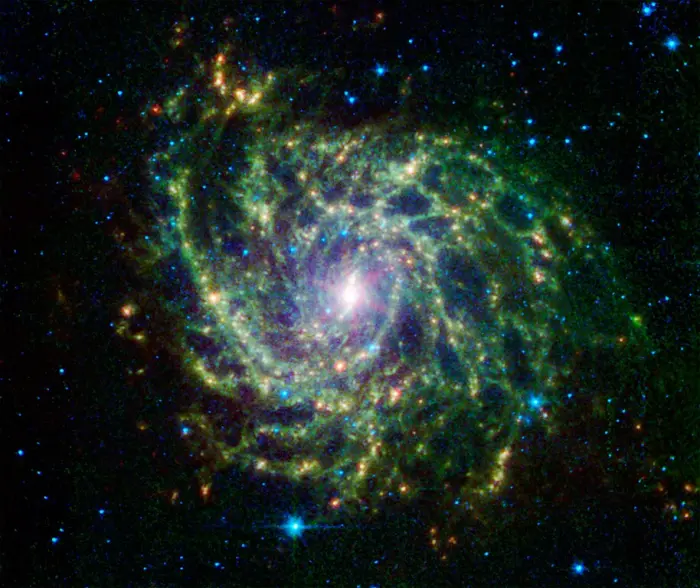
IC 342 captured by the Spitzer Space Telescope. Data from Spitzers infrared array camera (IRAC) are shown in blue (3.6 and 4.5 microns) and green (5.8 and 8.0 microns) while the multiband imaging photometer (MIPS) observation is red (24 microns). Credit: NASA/JPL-Caltech/J. Turner (UCLA) (PD)
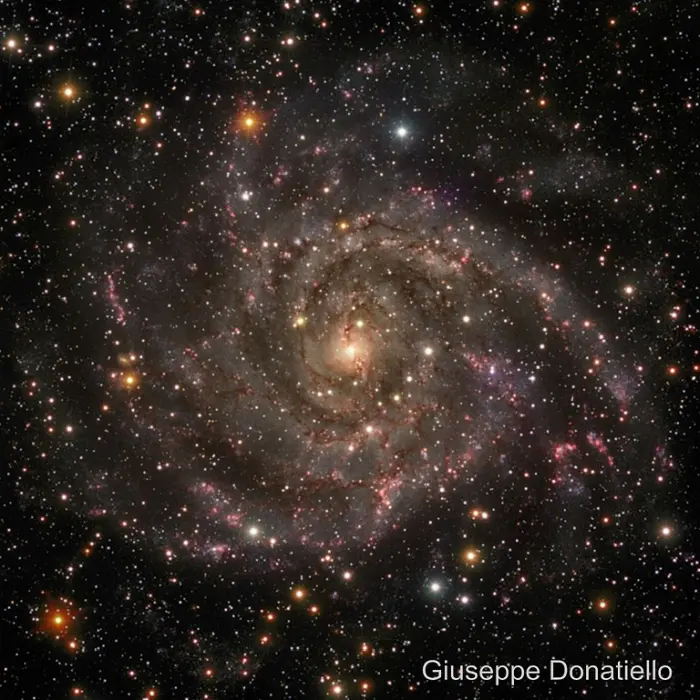
The Hidden Galaxy (Caldwell 5), image credit: Giuseppe Donatiello (CC0 1.0)